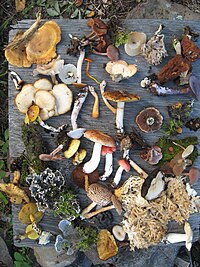
Photo from wikipedia
Managing and restoring faunal diversity across large areas requires an understanding of the roles of connectivity and dispersal in driving community patterns. We sought to determine the influence of connectivity,… Click to show full abstract
Managing and restoring faunal diversity across large areas requires an understanding of the roles of connectivity and dispersal in driving community patterns. We sought to determine the influence of connectivity, water regime, water source, geographical location, and dispersal traits on patterns of aquatic invertebrate diversity across a continent-wide arid biome. We compiled data on freshwater invertebrate assemblages from sites spanning the breadth of arid Australia. Univariate analyses (analysis of variance and rarefaction) revealed that alpha and gamma diversity across sites decreased as latitude increased. Multivariate analyses (ordination and analysis of similarity) revealed that community composition had considerable fidelity to geographic regions. Hydrological connectivity was strongly associated with riverine community composition although water rarely flowed (often less than annually). Hydrologically isolated sites (springs and rockholes) supported communities that were markedly dissimilar to hydrologically connected sites, and to each other. We investigated the influence of dispersal on diversity patterns by examining Distance Decay Relationships for each of four dispersal trait groups (obligate aquatic and passive, weak, and strong aerial dispersers) on the basis of geodesic (shortest path) distances between pairs of sites and Mantel tests. We did not detect clear differences between dispersal traits and distance decay relationships at the continental scale, even for the two groups with the lowest dispersal ability (obligate aquatics and passive dispersers.) Our results suggest that the loss of hydrological connectivity from water developments in arid lands (for example, the impoundment of intermittent rivers) is likely to affect macroinvertebrates. However, the exact flow mechanisms underlying such changes remain to be determined. This article is protected by copyright. All rights reserved.
Journal Title: Ecography
Year Published: 2017
Link to full text (if available)
Share on Social Media: Sign Up to like & get
recommendations!